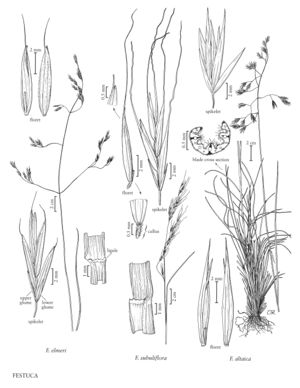Difference between revisions of "Festuca altaica"
FNA>Volume Importer |
imported>Volume Importer |
||
| (3 intermediate revisions by 2 users not shown) | |||
| Line 16: | Line 16: | ||
-->{{Treatment/Body | -->{{Treatment/Body | ||
| − | |distribution=Alaska;Mich.;Alta.;B.C.;Man.;Nfld. | + | |distribution=Alaska;Mich.;Alta.;B.C.;Man.;Nfld. and Labr.;N.W.T.;Que.;Sask.;Yukon |
|discussion=<p><i>Festuca altaica</i> is a plant of rocky alpine habitats, arctic tundra, and open boreal or subalpine forests. Its primary distribution extends from Alaska eastward to the western Northwest Territories, and south in the alpine regions of British Columbia and west-central Alberta. Disjunct populations occur in Quebec, western Labrador and Newfoundland, and in Michigan, where it may be introduced. From the Bering Sea it extends westward to the Altai Mountains of central Asia.</p><!-- | |discussion=<p><i>Festuca altaica</i> is a plant of rocky alpine habitats, arctic tundra, and open boreal or subalpine forests. Its primary distribution extends from Alaska eastward to the western Northwest Territories, and south in the alpine regions of British Columbia and west-central Alberta. Disjunct populations occur in Quebec, western Labrador and Newfoundland, and in Michigan, where it may be introduced. From the Bering Sea it extends westward to the Altai Mountains of central Asia.</p><!-- | ||
--><p>The spikelets of <i>Festuca altaica</i> are lustrous and usually intensely purplish; plants with greenish spikelets have been named <i>F. altaica</i> f. pallida Jordal. A form producing pseudoviviparous spikelets, <i>F. altaica</i> f. vivipara Jordal, has been described from Alaska.</p> | --><p>The spikelets of <i>Festuca altaica</i> are lustrous and usually intensely purplish; plants with greenish spikelets have been named <i>F. altaica</i> f. pallida Jordal. A form producing pseudoviviparous spikelets, <i>F. altaica</i> f. vivipara Jordal, has been described from Alaska.</p> | ||
| Line 35: | Line 35: | ||
|illustrator=Cindy Roché | |illustrator=Cindy Roché | ||
|illustration copyright=Utah State University | |illustration copyright=Utah State University | ||
| − | |distribution=Alaska;Mich.;Alta.;B.C.;Man.;Nfld. | + | |distribution=Alaska;Mich.;Alta.;B.C.;Man.;Nfld. and Labr.;N.W.T.;Que.;Sask.;Yukon |
|reference=None | |reference=None | ||
|publication title= | |publication title= | ||
|publication year= | |publication year= | ||
|special status= | |special status= | ||
| − | |source xml=https:// | + | |source xml=https://bitbucket.org/aafc-mbb/fna-data-curation/src/200273ad09963decb8fc72550212de541d86569d/coarse_grained_fna_xml/V24/V24_572.xml |
|subfamily=Poaceae subfam. Pooideae | |subfamily=Poaceae subfam. Pooideae | ||
|tribe=Poaceae tribe Poeae | |tribe=Poaceae tribe Poeae | ||
Latest revision as of 16:24, 11 May 2021
Plants densely cespitose, rarely with short rhizomes. Culms (25)30-90(120) cm, glabrous or slightly scabrous; nodes usually not exposed. Sheaths closed for less than 1/3 their length, glabrous or scabrous, persistent, not shredding into fibers; collars glabrous; ligules 0.2-0.6 (1) mm; blades deciduous, 2-4 mm wide, convolute, conduplicate, sometimes flat, 1-2.5 mm in diameter when conduplicate, yellow-green to dark green, abaxial surfaces scabrous, adaxial surfaces glabrous or pubescent, smooth or scabrous, veins 7-15(17), ribs 5-9; abaxial sclerenchyma in strands about as wide as the adjacent veins; adaxial sclerenchyma present; girders associated with the major veins. Inflorescences 5-16 cm, open, often secund, with 1-2(3) branches per node; branches lax, spreading, lower branches usually recurved or reflexed, spikelets borne towards the ends of the branches. Spikelets 8-14 mm, usually purple, lustrous, with 3-4(6) florets. Glumes glabrous or slightly scabrous, distinctly shorter than the adjacent lemmas; lower glumes 4-6.8(8.5) mm; upper glumes (4.5)5.3-7.5(10) mm; lemmas (6.5)7.5-9(12) mm, chartaceous, scabrous, at least on the veins, keeled on the lo'ver 1/2, veins 5, prominent, apices attenuate or short-awned, awns 0.2-0.7 mm; paleas about as long as or a little shorter than the lemmas, intercostal region puberulent distally; anthers 2.6-4.5(5) mm; ovary apices usually sparsely pubescent, rarely glabrous. 2n = 28.
Distribution
Alaska, Mich., Alta., B.C., Man., Nfld. and Labr., N.W.T., Que., Sask., Yukon
Discussion
Festuca altaica is a plant of rocky alpine habitats, arctic tundra, and open boreal or subalpine forests. Its primary distribution extends from Alaska eastward to the western Northwest Territories, and south in the alpine regions of British Columbia and west-central Alberta. Disjunct populations occur in Quebec, western Labrador and Newfoundland, and in Michigan, where it may be introduced. From the Bering Sea it extends westward to the Altai Mountains of central Asia.
The spikelets of Festuca altaica are lustrous and usually intensely purplish; plants with greenish spikelets have been named F. altaica f. pallida Jordal. A form producing pseudoviviparous spikelets, F. altaica f. vivipara Jordal, has been described from Alaska.
Selected References
None.
